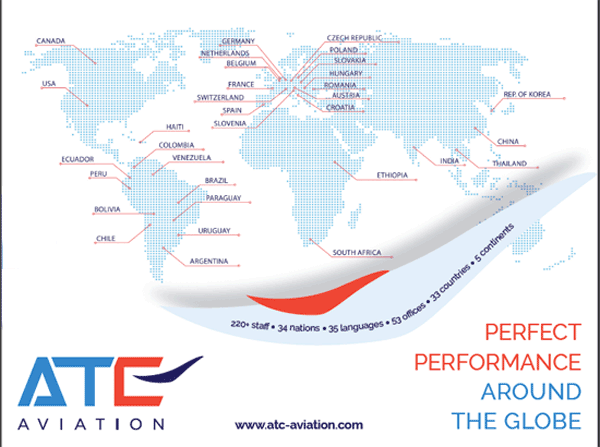
 |
 |
 #INTHEAIREVERYWHERE |
| Vol. 23 No. 20 | Tuesday April 23, 2024 |
| |
 |
All six people on this important panel presentation
held at The Cargo Network Services (CNS) Partnership Conference in Dallas,
Texas that included Alicia Lines, CNS President; (at Podium) and from
right, Cristina Oñate, VP Sustainability & Product, LATAM;
Lorenzo Stoll, Head of Cargo, Swiss WorldCargo; Juan Carlos Serna, Head
of Airfreight, CH Robinson; James Van Epps, Managing Director, Cargo Security,
Customs & DG, Airlines for America; and Robert Horton, Vice President,
Environmental Affairs & Sustainability, DFW International Airport
knocked the ball out of the stadium with an excellent presentation.
Robert Horton, Vice President,
Environmental Affairs & Sustainability, DFW International
noted that the host of the 2024 CNS Partnership Conference is, was and
continues to be proud as the first carbon-neutral airport in North America
eight years ago, achieving that goal in 2016. |
 |
When my family moved from Chicago to New York City, we lived near Forest Hills Stadium that was built in the neighborhood in 1923. The iconic structure that is still there and in business for concerts today is a 14,000-seat New York City Landmark. My mother Eleanor Jane, while in Scott High School in Toledo, Ohio won a national competition for writing poetry in 1932 at age 16 (my daughter Florence, our editor won the same prize at age 18). She moved our family to New York City in 1954 and went to work for a company named David Crystal in the then booming U.S. clothing business that was controlled at the time by companies in Manhattan. Crystal employed a man named Vincent Draddy, who was my Mom’s boss. Draddy cleverly engineered an agreement to import from France shiploads of white shirts with little alligators embossed on the left side front designed by Rene Lacoste, the French tennis star. Lacoste had been nicknamed ‘the crocodile.’ In America the shirts were branded Chemise LaCoste. Before long nearly everybody in tennis was wearing the white shirts, including yours truly who got them for free and wore them with some trepidation after my grade school mates mostly made fun of them. Anyway, my entrance and interest to tennis was linked to free shirts, or the tennis uniform of the time, and of course free tickets to the matches every year. The U.S. National Championships (renamed the US Open Tennis Championships in 1968) were played at Forest Hills Stadium from 1924 to 1977 until moving to The World’s Fair Stadium in Flushing where the event still is “Open every August”. For many years, even while publishing in air cargo, I used to cover the US Open for The Hollywood Reporter at the old Stadium. But before that, I remember seeing Joan Baez perform in the Stadium with a mystery guest, that most everyone had not heard of, named Bob Dylan in August of 1964. Covering the US Open for HR I would go into the clubhouse, post match and talk to the players: Billie Jean King and Arthur Ashe who were the big stars of my era, but I also got to see and talk to Pancho Gonzalez, and Lew Hoad, the Australian and some other greats of the past. I remember the comedian and satirist Alan King paddling around the Stadium, with a drink in his hand in suede slippers embroidered in gold with the initial A on one slipper and K on the other. That was a time when spectators could just walk around the big garden of courts and watch the matches. The best players in the world, while they were going at it for a shot at US Open Championship Finals, were up close to all in the Stadium. The great ones like Don Budge from the 1930s at the beginnings or Tony Trabert from the 1950s and all the others mentioned here who were winners, had their names engraved on plaques fastened to the elegant Forest Hills Stadium support pillars. I remember one evening in late August twilight talking to 17-year-old Chris Evert standing outside the Stadium with her parents before she had her run winning six US Opens Singles titles, setting the record beginning in 1975-82, (since tied by Serena Williams). Chris Evert and Jimmy Connors emerged as giants in women’s and men’s singles tennis. They were also for a while the ‘it’ couple in tennis. So for the fun, the sport and the romance of it, I have always thought air cargo should play tennis or something like it, to get closer to each other. Now the late Winter and early Spring trade shows for air cargo are in the rear-view mirror for 2024, at least until TIACA meets in Miami, November 11-14 so what is left in the next few summer months into the fall for networking ourselves and maybe learning something new from and about each other? Yes, there will be monthly meetings and golf outings and even picnics of various air cargo clubs and other air cargo groups, and later in the year ready, set, go come the pop-up events of one or two days put up as “most necessary” on-site, pay-per-view all over the world. But air cargo, looking for something to lift spirits and network in the long hot summer and months until the Fall show season appears again, might expand use of a social and competitive contact sport, original and downright different as seen at Schiphol Air Cargo in Amsterdam. Here a group has formed an Air Cargo Padel Club that held its first event in 2023 and now has Registration Open for a Second Air Cargo Padel to be held at The Padel Mate Club in nearby Amstelveen June 13, 2024. Sponsors for Air Cargo Padel 2024 include: E-Freight Forwarding, Avi Air, United Cargo, SVAAA, Trip & Co, ACN Air Cargo Netherlands, Fr8, Cargo Aviation Management & Recruitment B.V., Padel Mate Club, Malenstein Global Logistics. Contact here. What we really like about Padel is a friendly competition, very similar to tennis, playable on a court about 33 by 66 feet, or about a third the size of a tennis court. Scoring is tennis, but 99% of the play is doubles play. That means that people from various skill levels can go out and play and have fun right away and since the play is most often a doubles match, lots of team spirit gets generated. Here is how Padel goes: You start with an underhand serve. After you serve, the ball must bounce onto the turf, and you can play off the walls and play off the side. If tennis is checkers, Padel is chess. It's really a thinking person's sport, but the great thing about Padel, is the game is easy to learn and hard to master. At last count there are about 300 public and private Padel Courts in the U.S. but worldwide there are 40,000, with growth booming everywhere, as the sport is expanding at 26% annually. Market size for Padel is put at $327 million, with 25 million players in 110 countries. It is important to point out at this juncture, in the rapidly expanding and ever changing ‘for the better’ world of air cargo, more than 38% of the hearty souls engaged in Padel, are female. For the record, the family that own The New Yankees Baseball Club, the richest sports franchise in the world, and also Premier Padel, backed by Qatar Sports Investments are both onboard rather big-time for Padel. Here is the video from Air Cargo Padel at Schiphol. Geoffrey |
|
Bella
Donna—A Thoughtful Tally For Kale
|
The deluge flooded out Dubai Airport and other UAE gateways and elsewhere in the Middle East creating chaotic conditions all around. Everyone in the air, on land and on the sea could only stand by and hope for better weather as the rain shut down everything; filling up gateways with people and cargo and packing every available hotel room, as uncertainty was the rule. The heavy rains lashed the United Arab Emirates beginning last Tuesday April 18 , flooding out major highways, stranding people, with vehicles abandoned on roadways across Dubai. Meanwhile, the death toll in Dubai is put at 4, as separate heavy flooding in neighboring Oman was worse at 20 deaths reported, and others still counted as missing. “Heavy rainfall over the desert landscape of the Gulf is not unheard of, and residents were warned via a public alert system - but Dubai's weather infrastructure’ was clearly unprepared for the worst rain since 1949,” BBC reported. Scientists warned the record-breaking rainfall that brought the city-state to a standstill dumped more than a year-and-a-half’s worth of rain on Dubai in a matter of hours and could have been driven by climate change. By Sunday April 21 as airport operations slowly inched back to normal, Emirates said it was at full schedule, while other carriers were not as lucky. Backlogs of everything and everyone that flies are not expected to fully recover across the board for several days. GDA |
 |
 |
If
You Missed Any Of The Previous 3 Issues Of FlyingTypers Access complete issue by clicking on issue icon or Access specific articles by clicking on article title |
||
 Vol. 23 No. 17 CNS In Sullivan's World |
 Vol. 23 No.18 Lines In The Sand Chuckles for April 15, 2024 State Of The Air Cargo Industry United Picture Tells A Story |
|
Publisher-Geoffrey Arend
• Managing Editor-Flossie Arend • Editor Emeritus-Richard
Malkin Film Editor-Ralph Arend • Special Commentaries Editor-Bob Rogers • Special Assignments-Sabiha Arend, Emily Arend |
Send comments and news to geoffrey@aircargonews.com
|